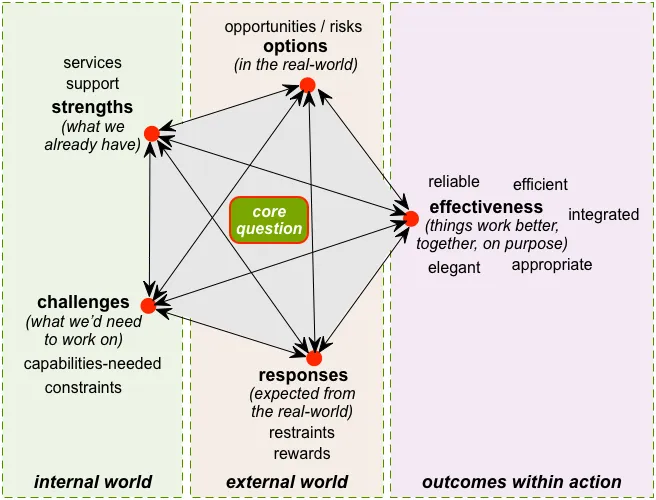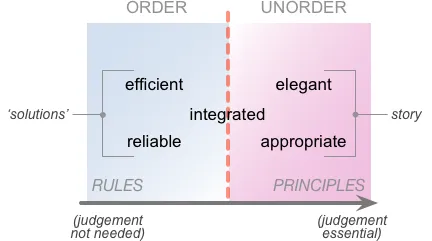On effectiveness, solutions and story
Blog: Tom Graves / Tetradian
Just a quick note, this one, to document an item that came up somewhen during my recent travels.
Several of the workshops had focussed on the SCORE frame, to help people map out themes that were relevant for strategy and change:

(This is an old SCORE layout that I would rarely use these days, but it’s one that that emphasises effectiveness, which is the focus for this specific blog-post. For the current SCORE layout and its use, see slides 113-130 in this slidedeck.)
In the workshops, there’d been a lot of discussion about effectiveness – about how we can map it, model it, identify the factors that underpin it, why and how everything in an architecture needs to connect back to at least one or more of the selected effectiveness-themes, and so on. In practice, the underpinnings for effectiveness are different for every organisation – depending in part on the enterprise(s) with which the organisations intersect – but should always include the following as a default minimum set of effectiveness-themes:
- Efficient: optimises use of resources, minimises wastage of resources
- Reliable: predictable, consistent, self-correcting, supports ‘single source of truth’ etc
- Elegant: clarity, simplicity, consistency, self-adapting for human factors
- Appropriate: supports and optimises support for business purpose
- Integrated: creates, supports and optimises synergy across all systems
One of the questions that came up in that discussion was around governance, and how rules and principles might apply differently for each of these themes. It soon became clear that the simplest way to describe this would be to map it out on a simplified version of the SCAN frame, without SCAN’s usual vertical-axis for time, which wasn’t relevant for this context:

As the diagram shows, efficiency and reliability are more predictable, more ‘ordered’, and hence more easily subject to predefined rules and analysis – which is perhaps why Taylorist trained managers tend to over-focus on those themes. By contrast, elegance (simplicity and the like) and appropriateness (staying ‘on-purpose’) are themes that are both more blurry, more human, more ‘unordered’, and hence need to be governed more by uncertainty-friendly means such as principles and guidelines. Unsurprisingly, the final default effectiveness-theme of integration kind of sits in the middle, somewhere between all of the other themes, holding the balance between them.
Perhaps the most interesting distinction here is also shown in the diagram above – the tendency of those themes to cluster into ‘solutions’ versus story:
– When there’s an over-focus on rules and predictability, there tends also to be an over-focus on efficient and reliable – leading to a tendency to create ‘solutions’ that have little to no connection with the broader enterprise-story.
– When there’s an over-focus on principles and possibility, there tends also to be an over-focus on elegant and appropriate – leading to a tendency to create a story that looks great on paper but is not actually implementable as ‘solutions’.
– In each case, we need a firm emphasis on integration to provide the needed balance between ‘solutions’ (structure) and story.
No particular point being made here: just thought it might be useful, that’s all.